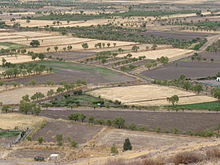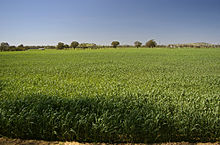- Dryland farming
-
Dryland farming is an agricultural technique for non-irrigated cultivation of drylands.
Contents
Locations
 Fields in the Palouse, USA
Fields in the Palouse, USA
Dryland farming is used in the Great Plains, the Palouse plateau of Eastern Washington, and other arid regions of North America, the Middle East and in other grain growing regions such as the steppes of Eurasia and Argentina. Dryland farming was introduced to southern Russia and Ukraine by Russian Mennonites under the influence of Johann Cornies, making the region the breadbasket of Russia.[1] In Australia, it is widely practiced in all states but the Northern Territory.
Crops
Winter wheat is the typical crop although skilled dryland farmers sometimes grow corn, beans or even watermelons. Successful dryland farming is possible with as little as 9 inches (230 mm) of precipitation a year; higher rainfall increases the variety of crops. Native American tribes in the arid Southwest subsisted for hundreds of years on dryland farming in areas with less than 10 inches (250 mm) of rain.[citation needed] The choice of crop is influenced by the timing of the predominant rainfall in relation to the seasons. For example, winter wheat is more suited to regions with higher winter rainfall while areas with summer wet seasons may be more suited to summer growing crops such as sorghum, sunflowers or cotton.[2]
Process
Dryland farming has evolved as a set of techniques and management practices used by farmers to continually adapt to the presence or lack of moisture in a given crop cycle. In marginal regions, a farmer should be financially able to survive occasional crop failures, perhaps for several years in succession.[citation needed] Survival as a dryland farmer requires careful husbandry of the moisture available for the crop and aggressive management of expenses to minimize losses in poor years.
System
 Dryland farming caused a large dust storm in parts of Eastern Washington on October 4, 2009. Courtesey: NASA/GSFC, MODIS Rapid Response[3]
Dryland farming caused a large dust storm in parts of Eastern Washington on October 4, 2009. Courtesey: NASA/GSFC, MODIS Rapid Response[3]
Dryland farming is uniquely dependent on natural rainfall, which can leave the ground vulnerable to dust storms, particularly if poor farming techniques are used or if the storms strike at a particularly vulnerable time. The fact that a fallow period must be included in the crop rotation means that fields cannot always be protected by a cover crop, which might otherwise offer protection against erosion.
Key elements
Capturing and Conservation of Moisture - In regions such as Eastern Washington state, the average annual precipitation available to a dryland farm may be as little as 8.5 inches (220 mm). Consequently moisture must be captured until the crop can utilize it. Techniques include summer fallow rotation (in which one crop is grown on two seasons' precipitation, leaving standing stubble and crop residue to trap snow, and preventing runoff by terracing fields.
"Terracing" is also practiced by farmers on a smaller scale by laying out the direction of furrows to slow water runoff downhill, a practice known as contour plowing. Moisture can be conserved by eliminating weeds and leaving crop residue to shade the soil.
Effective Use of Available Moisture - Once moisture is available for the crop to use, it must be used as effectively as possible. Seed planting depth and timing are carefully considered to place the seed at a depth at which sufficient moisture exists, or where it will exist when seasonal precipitation falls. Farmers tend to use crop varieties which are drought and heat-stress tolerant, (even lower-yielding varieties). Thus the likelihood of a successful crop is hedged if seasonal precipitation fails.
Soil Conservation - The nature of dryland farming makes it particularly susceptible to erosion, especially wind erosion. Some techniques for conserving soil moisture (such as frequent tillage to kill weeds) are at odds with techniques for conserving topsoil. Since healthy topsoil is critical to sustainable dryland agriculture, its preservation is generally considered[citation needed] the most important long-term goal of a dryland farming operation. Erosion control techniques such as windbreaks, reduced tillage or no-till, spreading straw (or other mulch on particularly susceptible ground), and strip farming are used to minimize topsoil loss.
Control of Input Costs - Dryland farming is practiced in regions inherently marginal for non-irrigated agriculture. Because of this, there is an increased risk of crop failure and poor yields which may occur in a dry year (regardless of money or effort expended). Dryland farmers must evaluate the potential yield of a crop constantly throughout the growing season and be prepared to decrease inputs to the crop such as fertilizer and weed control if it appears that it is likely to have a poor yield due to insufficient moisture. Conversely, in years when moisture is abundant, farmers may increase their input efforts and budget to maximize yields and to offset poor harvests.
See also
- International Center for Agricultural Research in the Dry Areas
- Sustainable agriculture
- Xeriscaping
- Irrigation
- Seawater Greenhouse
Notes
- ^ Smith, C. Henry (1981). Smith's Story of the Mennonites. Newton, Kansas: Faith and Life Press. pp. 263–265. ISBN 0-87303-069-9.
- ^ Malcolm, Bill; Sale, Peter"; Egan, Adrian (1996). Agriculture in Australia - An Introduction. Australia: Oxford University Press. ISBN 0 19 553695 9.
- ^ "Dust Storm in Eastern Washington : Image of the Day". earthobservatory.nasa.gov. http://earthobservatory.nasa.gov/IOTD/view.php?id=40590. Retrieved 2009-10-10.
Further reading
- Henry Gilbert, Dryland Farming: January 1982-December 1990 (Beltsville, Md.: U.S. Department of Agriculture, National Agricultural Library, 1991).
- Mary W. M. Hargraves, Dry Farming in the Northern Great Plains: Years of Readjustment, 1920-1990 (Lawrence: University of Kansas, 1993).
- Oklahoma State Board of Agriculture, Report (Guthrie, Okla.: N. p., 1908).
- Dr. John A. Widstoe,Ph.D. Dry-Farming, A System Of Agriculture For Countries Under A Low Rainfall (NY: The MacMillian Company, 1911)
- Victor Squires and Philip Tow, Dryland Farming: A Systems Approach - An Analysis of Dryland Agriculture in Australia (Sydney: Sydney University Press, 1991)
External links
 Media related to Dryland farming at Wikimedia CommonsCategories:
Media related to Dryland farming at Wikimedia CommonsCategories:
Wikimedia Foundation. 2010.


